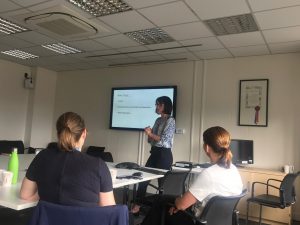 Tuesday 11th June saw the second installment of the Healthcare Professional Academic Group (HPAG) lunchtime seminars. 15 members of the group were in attendance for two hugely insightful talks from Professor Alison McGregor and Claire Leon Villapalos.
Tuesday 11th June saw the second installment of the Healthcare Professional Academic Group (HPAG) lunchtime seminars. 15 members of the group were in attendance for two hugely insightful talks from Professor Alison McGregor and Claire Leon Villapalos.
Alison is a Professor in Musculoskeletal Biodynamics and gave a talk entitled ‘Keeping Amputees on their feet’ highlighting her work with the Centre for Blast Injury Support at Imperial College London. A lot of the work is about understanding the long-term health of amputees and the challenges involved in this including stump health, back pain, ageing, well being, social integration, osteoporosis and employment. All of these being contributing factors involved when developing more advanced prototypes in prosthesis.
In individuals that wear stumps there are never-ending issues with infection and inability to wear them for long periods. As most amputees have no feeling in the limb to which the stump is attached to, they do not feel pain or pressure which overall leads to problems and worsening medical woes. With this fact in mind, the students within the Blast Unit have been working with a team from the Department of engineering on a smart socket prototype which includes sensors that can identify pain and pressure points. This sends signals to a mobile phone which can also give indication for adjustments and fit of the stump.
Olympic Medalist Dave Henson is one of the students involved in this, using his own experience of prosthesis within competitive sport as well as every day life really bridging the gap in sport, engineering and medical research. There is still some work to be done but the future looks bright for amputees.
Claire Leon Villapalos is an Honorary Clinical Research Fellow at Imperial and using her nursing background as a basis for research in safety in a clinical background. Her talk entitled ‘An exploration of the relationships between staff and perceptions of safety in adult intensive care (ICU) and staffing, patient and work environment characteristics’ reflected the research that she did to understand the perception of health and safety within a clinical environment and staff involvement. Most individuals would define safety as checks on surroundings or equipment but within a medical environment, staff safety and how safe they feel under low and high-risk circumstances in a huge every day challenge. In order to assess this, Claire set up a traffic light system in which staff were asked to tick red (least Safe), yellow (safety concerns) or green (mostly safe) during each shift; this was to try to understand the key factors that made staff less safe based on workload intensity, care hours per patient, number of patients in side rooms, level of patients medical needs. By the end of the research, there were a total od 2836 responses giving good gravitas to produce relevant findings. It was shown that staff actually felt safer with more acute patients, but findings show that there are more staff taking care of these patients compared to less acute which poses questions as to whether staffing models are more focused towards sicker patients. Stage two of this research involved a more structured interview process in order to get the views and highlight the good and bad points from all medical staff. Claire is to do further research to involve patients, families and equipment which in turn hopefully will attain further funding to hopefully change the dynamics in a crucial area of clinical work.
Both Alison and Claire got full engagement, and both had an influx of questions and further highlighted the impact of HPAG and the need to really support healthcare professionals who are such a fundamental part of medicine and research.
Next Seminar TBC for the Autumn.
